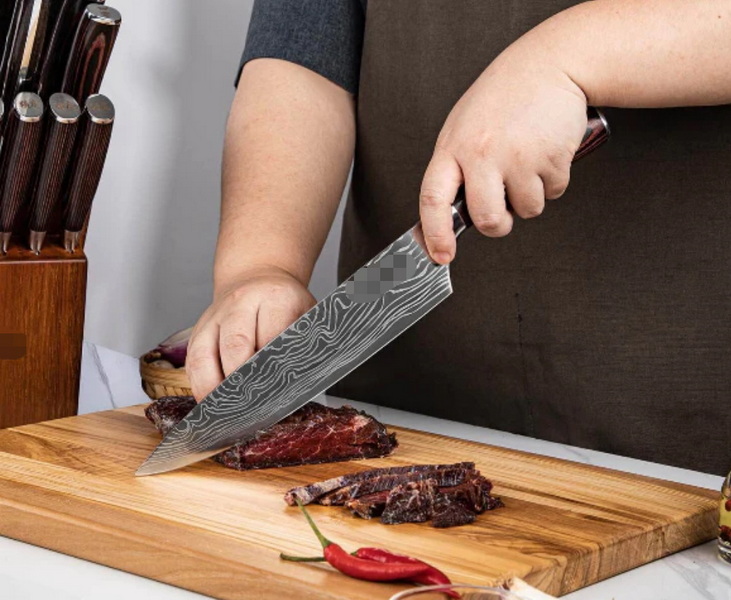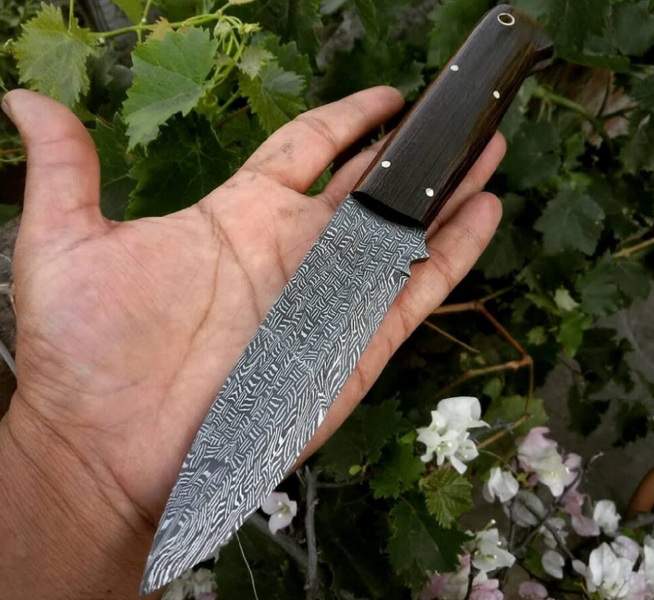- All
- Product Name
- Product Keyword
- Product Model
- Product Summary
- Product Description
- Multi Field Search
Views: 222 Author: Ann Publish Time: 2025-10-14 Origin: Site











Content Menu
● Why Choose a Damascus Knife?
● Exploring the Different Damascus Steel Patterns
● Key Factors to Consider When Choosing a Damascus Knife
>> 1. Purpose and Intended Use
>> 2. Blade Material and Core Steel
>> 3. Handle Comfort and Material Choice
>> 4. Blade Length and Thickness
>> 6. Maintenance and Care Requirements
● Additional Considerations When Buying a Damascus Knife
>> Authenticity and Craftsmanship
● Frequently Asked Questions (FAQs)
>> Q1: How do I maintain and clean a Damascus knife?
>> Q2: Are Damascus knives rust-resistant?
>> Q3: Can Damascus knives be sharpened with standard tools?
>> Q4: Does the Damascus pattern affect cutting performance?
>> Q5: Are Damascus knives suitable for professional chefs?
Damascus knives are celebrated worldwide for their strikingly beautiful patterns, exceptional sharpness, and lasting durability. Whether you are a professional chef or a passionate home cook, selecting the right Damascus knife can elevate your culinary experience significantly. This comprehensive guide will help you understand what Damascus knives are, the unique qualities that set them apart, and how to choose the perfect one tailored to your specific cooking requirements.

A Damascus knife is crafted from Damascus steel, which involves forging multiple layers of steel together to create a blade with distinctive, flowing water-like or patterned designs. These layered steel blades have a storied history dating back centuries, originally known as Wootz steel from the Middle East. Today, modern Damascus knives use advanced steel alloys layered together to replicate the original strength and beauty. The visible patterns are not only aesthetic but also indicate a blade's quality and the expertise involved in its making.
There are several compelling reasons to invest in a Damascus knife for your kitchen:
- Superior Sharpness and Edge Retention: The multi-layered steel construction results in a blade that holds a very sharp edge longer than many conventional knives.
- Exceptional Durability: Damascus knives resist chipping and wear, thanks to the blend of hard and flexible steels forged together.
- Aesthetic Appeal: Each blade displays a unique pattern, making your knife a piece of functional art.
- Versatility: Available in various shapes and sizes suitable for different kitchen tasks, from chopping vegetables to filleting fish.
The Damascus steel blade patterns are varied and can help you identify a knife's style and even sometimes its method of manufacture:
- Feather Pattern: Characterized by soft, flowing lines resembling feathers, indicating careful layering.
- Ladder Pattern: Resembles the rungs of a ladder with linear stripes stacked symmetrically.
- Raindrop Pattern: Marked by circular or oval “drops” scattered on the blade surface.
- Swirl and Twist Patterns: More artistic and random, created by twisting the steel layers during forging.
Each pattern is unique and often enhances the beauty and mystique of the knife, making it appealing both for daily use and as a collector's item.
Selecting the right Damascus knife involves several important factors tailored to your culinary routine:
Identify the primary tasks you want the knife to perform. Damascus knives come in numerous types:
- Chef's Knife: The all-rounder, perfect for slicing, chopping, and dicing.
- Santoku Knife: A versatile Japanese-style knife suited for precise cuts.
- Cleaver: Ideal for heavy-duty chopping and separating bones.
- Paring Knife: Small and precise for peeling and trimming.
- Utility Knife: A mid-sized knife for miscellaneous kitchen tasks.
Each type offers different advantages, so matching the knife style to your cooking habits is essential.
While the outer layers create the Damascus pattern, the inner core steel largely determines the blade's cutting performance. Popular core steels include VG10, 1095 carbon steel, or AUS-8. High-quality core steels are hard enough to hold an edge but flexible enough to resist breaking. When choosing a knife, inquire about the core steel type and hardness rating (usually measured in Rockwell Hardness Scale, HRc).
The handle is critical for control and comfort. Common materials include:
- Wood: Traditional and attractive but may require more care.
- Micarta: A durable composite resin that resists moisture.
- G-10 or Resin: Modern synthetic materials offering excellent grip and durability.
Try holding the knife to ensure the handle suits your hand size and grip style.
- Longer blades (8-10 inches): Great for slicing large vegetables and meats efficiently.
- Shorter blades (5-7 inches): Provide better precision for delicate tasks.
Thickness also affects performance; thinner blades slice cleaner but may be more fragile, whereas thicker blades are robust but less ideal for precision cuts.

- Double-beveled edges: Sharpened on both sides, common in Western-style knives.
- Single-beveled edges: Sharpened on one side, typical in traditional Japanese knives, offering sharper precision.
The edge angle influences sharpness and durability. Narrow angles create sharper edges but require more maintenance.
Damascus knives need care to maintain their beauty and function:
- Always hand wash and dry immediately.
- Avoid dishwasher use or harsh detergents.
- Regular honing and occasional sharpening with appropriate stones or systems.
- Oil the blade periodically to prevent rust, especially if carbon steel is used in the core.
There are many knives labeled “Damascus” but made with varying quality. Look for information about the forging process and layers count. Genuine Damascus knives often are hand-forged by skilled artisans, whereas some mass-produced ones use acid-etched patterns over standard steel.
The knife should feel balanced when held. A poorly balanced knife can cause fatigue or reduce cutting precision, so consider the blade-to-handle ratio and overall weight.
Damascus knives range from affordable to luxury prices. While high price often indicates better materials and craftsmanship, some budget models offer excellent value. Identify what features are most important to your cooking needs.
Choosing the right Damascus knife enhances your cooking performance and adds beauty to your kitchen tools. It requires balancing factors such as knife type, blade construction, handle comfort, and maintenance needs. Genuine Damascus knives with high-quality core steel and expert forging offer unmatched sharpness, durability, and unique aesthetics. With the proper care, a Damascus knife can become a lifelong culinary companion that combines artistry with precision.

A: Hand wash with mild soap, dry thoroughly right after use, and avoid dishwashers. Regularly hone and sharpen the blade using sharpening stones suited for layered steel. Occasionally apply a light coat of mineral oil to prevent rust, especially if the core steel contains carbon.
A: Modern Damascus knives typically use stainless steel layers that resist rust. However, the core steel may be prone to corrosion if improperly maintained. Proper cleaning and drying after each use are essential to maintain rust resistance.
A: Yes, they can be sharpened with standard whetstones or sharpening systems, but it's best to use fine-grit stones for the layered steel to protect the knife's edge and pattern.
A: The pattern itself is mostly aesthetic and indicative of the knife's layered construction. Cutting performance depends on the inner core steel quality, blade geometry, and heat treatment.
A: Absolutely. Many professional chefs prefer Damascus knives because they combine sharpness, edge retention, durability, and aesthetic appeal.
The Ultimate Professional Knives for Halal Butchery in Middle Eastern Kitchens
Chef Knife Size Guide: Choosing Between 6″, 8″, 10″, And 12″
Custom Knife Handles: How To Design A Chef Knife That Fits Your Hand Perfectly
Chef Knife Surface Treatments Guide: From Polished Migaki To Damascus Patterns
Inside Our Professional Knife Sample Room: Quality You Can See
Universal Knife Block Buying Guide: Modern Acrylic & ABS Knife Holders for Professional Kitchens
Universal Knife Block: The Complete Guide To Modern, Hygienic Knife Storage
The Complete Guide To Red Handle Knife Sets: Style Meets Functionality in The Kitchen
Professional Knives for Halal Butchery And Middle Eastern Cuisine